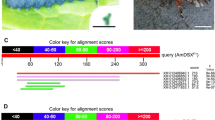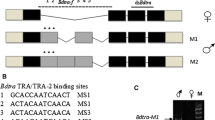Abstract
Doublesex (dsx) is a double-switch gene at the bottom of the somatic sex-determination hierarchy which regulates sexual dimorphism in many insects. Here, Drosophila melanogaster homologues of dsx were isolated in two Bactrocera species, the oriental fruit fly, B. dorsalis, and the guava fruit fly, B. correcta. Results of RT–PCR analysis suggests that both the B. dorsalis dsx (Bd1dsx) and B. correcta dsx (Bcdsx) genes are transcribed and sex-specifically spliced in accordance with the Drosophila sex-specific splicing mechanism. The cDNA sequences shared a high degree of similarity at the nucleotide level among the Bactrocera species. Structurally conserved domains for DNA-binding and oligomerization were observed in all transcripts suggesting that their proteins function as transcriptional factors for downstream sex-specific gene expression. A purine-rich element (PRE) and four repeat elements (dsxRE) for TRA/TRA-2 binding sites were also found in the 3′ untranslated regions (UTR) of both the female Bd1dsx and Bcdsx mRNAs. Notably, a putative core promoter was revealed in Bd1dsx, being probably the first dsx promoter discovered in the tephritid flies.






Similar content being viewed by others
References
Alvarez M, Ruiz MF, Sanchez L (2009) Effect of the gene doublesex of Anastrepha on the somatic sexual development of Drosophila. PLoS ONE 4(4):e5141. doi:10.1371/journal.pone.0005141
An W, Cho S, Ishii H, Wensink PC (1996) Sex-specific and non-sex-specific oligomerization domains in both of the doublesex transcription factors from Drosophila melanogaster. Mol Cell Biol 16:3106–3111
Baruffi L, Damiani G, Guglielmino CR, Bandi C, Malacrida AR, Gasperi G (1995) Polymorphism within and between populations of Ceratitis capitata: comparison between RAPD and multilocus enzyme electrophoresis data. Heredity 74:425–437
Boggs RT, Gregor P, Idriss S, Belote JM, McKeown M (1987) Regulation of sexual differentiation in D. melanogaster via alternative splicing of RNA from the transformer gene. Cell 50:739–747
Burtis KC, Baker BS (1989) Drosophila doublesex gene controls somatic sexual differentiation by producing alternatively spliced mRNAs encoding related sex-specific polypeptides. Cell 56:997–1010
Butler JE, Kadonaga JT (2002) The RNA polymerase II core promoter: a key component in the regulation of gene expression. Genes Dev 16:2583–2592
Chen S, Dai S, Lu K, Chang C (2008) Female-specific doublesex dsRNA interrupts yolk protein gene expression and reproductive ability in oriental fruit fly, Bactrocera dorsalis (Hendel). Insect Biochem Mol Biol 38:155–165
Cho S, Wensink PC (1997) DNA binding by the male and female doublesex proteins of Drosophila melanogaster. J Biol Chem 272:3185–3189
Cho S, Wensink PC (1998) Linkage between oligomerization and DNA binding in Drosophila doublesex proteins. Biochemistry 37:11301–11308
Cho S, Huang ZY, Zhang J (2007) Sex-specific splicing of the honeybee doublesex gene reveals 300 million years of evolution at the bottom of the insect sex-determination pathway. Genetics 177:1733–1741
Cline TW (1993) The Drosophila sex determination signal: how do flies count to two? Trends Genet 9:386–390
Frohman MA, Dush MK, Martin GR (1988) Rapid production of full-length cDNAs from rare transcripts: amplifications using a single gene-specific oligonucleotide primer. Proc Natl Acad Sci USA 85:8998–9002
Fu G, Condon KC, Epton MJ, Gong P, Jin L, Condon GC, Morrison NI, Dafa’alla TH, Alphey L (2007) Female-specific insect lethality engineered using alternative splicing. Nature Biotech 25:353–357
Gabrieli P, Falaguerra A, Siciliano P, Gomulski LM, Scolari F, Zacharopoulou FG, Malacrida AR, Gasperi G (2010) Sex and the single embryo: early development in the Mediterranean fruit fly, Ceratitis capitata. Dev Biol 10:12. doi:10.1186/1471-213X-10-12
Gouw JW, Pinkse MW, Vos HR, Moshkin Y, Verrijzer CP, Heck AJ, Krijgsveld J (2009) In vivo stable isotope labeling of fruit flies reveals post-transcriptional regulation in the maternal-to-zygotic transition. Mol Cell Proteomics 8(7):1566–1578
Graham P, Penn JKM, Schedl P (2003) Masters change, slaves remain. Bio Essays 25:1–4
Hediger M, Burghardt G, Siegenthaler C, Buser N, Hilfiker-Kleiner D, Duendorfer A, Bopp D (2004) Sex determination in Drosophila melanogaster and Musca domestica converges at the level of the terminal regulator doublesex. Dev Genes Evol 214:29–42
Hodgkin J (1989) Drosophila sex determination: a cascade of regulated splicing. Cell 56:905–906
Inoue K, Hoshijima K, Sakamoto H, Shimura Y (1990) Binding of the Drosophila Sex-lethal gene product to the alternative splice site of transformer primary transcript. Nature 344:461–463
Juven-Gershon T, Hsu JY, Kadonaga JT (2006) Perspectives on the RNA polymerase II core promoter. Biochem Soc Trans 34:1047–1050
Kuhn S, Sievert V, Traut W (2000) The sex-determining gene doublesex in the fly Megaselia scalaris: conserved structure and sex-specific splicing. Genome 43:1011–1020
Lagos D, Ruiz MF, Sanchez L (2005) Isolation and characterization of the Bactrocera oleae genes orthologous to the sex determination Sex-lethal and doublesex genes of Drosophila melanogaster. Gene 348:111–121
Lagos D, Koukidou M, Savakis C, Komitopoulou K (2007) The transformer gene in Bactrocera oleae: the genetic switch that determines its sex fate. Insect Mol Biol 16:221–230
Ohbayashi F, Suzuki M, Mita K, Okano K, Shimada T (2001) A homologue of the Drosophila doublesex gene is transcribed into sex-specific mRNA isoforms in the silkworm, Bombyx mori. Comp Biochem Physiol 128:145–158
Pane A, Salvemini M, Delli BP, Polito C, Saccone G (2002) The transformer gene in Ceratitis capitata provides a genetic basis for selecting and remembering the sexual fate. Development 129:3715–3725
Permpoon R, Thanaphum S (2010) Isolation and characterization of oligomerization domain I and II coding regions of doublesex genes in agricultural fruit flies (Diptera: Tephritidae). Eur J Entomol 107:121–126
Raymond CS, Shamu CE, Shen MM, Seifert KJ, Hirsch B, Hodgkin J, Zarkower D (1998) Evidence for evolutionary conservation of sex-determining genes. Nature 391:691–695
Raymond CS, Parker ED, Kettlewell JR, Brown LG, Page DC, Kusz K, Jaruzelska J, Reinberg Y, Flejter WL, Bardwell VJ, Hirsch B, Zarkower D (1999a) A region of human chromosome 9p required for testis development contains two genes related to known sexual regulators. Hum Mol Gen 8:989–996
Raymond CS, Kettlewell JR, Hirsch B, Bardwell VJ, Zarkower D (1999b) Expression of Dmrt1 in the genital ridge of mouse and chicken embryos suggests a role in vertebrate sexual development. Dev Biol 215:208–220
Robinett CC, Vaughan AG, Knapp JM, Baker BS (2010) Sex and the single cell. II. There is a time and place for sex. PLoS Biol 8(5):e1000365. doi:10.1371/journal.pbio.1000365
Ruiz MF, Stefani RN, Mascarenhas RO, Perondini ALP, Selivon D, Sanchez L (2005) The gene doublesex of the fruit fly Anastrepha obliqua (Diptera, Tephritidae). Genetics 171:849–854
Ruiz MF, Eirin-Lopez M, Stefani RN, Perondini ALP, Selivon D, Sanchez L (2007) The gene doublesex of Anastrepha fruit flies (Diptera, Tephritidae) and its evolution in insects. Dev Genes Evol 217:725–731
Saccone G, Peluso I, Testa G, Di Paola F, Pane A, Polito LC (1996) Drosophila Sex-lethal and doublesex homologous genes in Ceratitis capitata: searching for sex-specific genes to develop a medfly transgenic sexing strain, in enhancement of the sterile insect technique through genetic transformation using nuclear techniques. IAEA/FAO, Vienna
Saccone G, Peluso I, Astiaco D, Giordano E, Bopp D, Polito LC (1998) The Ceratitis capitata homologue of the Drosophila sex-determining gene Sex-lethal is structurally conserved, but not sex-specifically regulated. Development 125:1495–1500
Saccone G, Pane A, Polito LC (2002) Sex determination in flies, fruit flies and butterflies. Genetica 116:15–23
Saccone G, Salvemini M, Pane A, Polito LC (2008) Masculinization of XX Drosophila transgenic flies expressing the Ceratitis capitata DoublesexM isoform. Int J Dev Biol 52:1051–1057
Salvemini M, Robertson M, Aronson B, Atkinson P, Polito LC, Saccone G (2009) Ceratitis capitata transformer-2 gene is required to establish and maintain the autoregulation of Cctra, the master gene for female sex determination. Int J Dev Biol 53:109–120
Sambrook J, Fritsch EF, Maniatis T (1989) Molecular cloning, 2nd edn. Cold Spring Harbor Laboratory Press, New York
Sanchez L (2008) Sex-determining mechanisms in insects. Int J Dev Biol 52:837–856
Scali C, Catteruccia F, Li Q, Crisanti A (2005) Identification of sex-specific transcripts of the Anopheles gambiae doublesex gene. J Exp Biol 208:3701–3709
Schutt C, Nothiger R (2000) Structure, function and evolution of sex-determining systems in Dipteran insects. Development 127:667–677
Shearman DCA (2002) The evolution of sex determination system in dipteran insects other than Drosophila. Genetica 116:25–43
Shearman DC, Frommer M (1998) The Bactrocera tryoni homologue of the Drosophila melanogaster sex-determination gene doublesex. Insect Mol Biol 7:355–366
Sievert V, Kuhn S, Traut W (1997) Expression of the sex determination cascade genes Sex-lethal and doublesex in the phorid fly Megaselia scalaris. Genome 40:211–214
Suzuki MG, Ohbayashi F, Mita K, Shimada T (2001) The mechanism of sex specific splicing at the doublesex gene is different between Drosophila melanogaster and Bombyx mori. Insect Biochem Mol Biol 31:1201–1211
Suzuki MG, Funaguma S, Kanda T, Tamura T, Shimada T (2003) Analysis of the biological functions of a doublesex homologue in Bombyx mori. Dev Genes Evol 213:345–354
Thompson JD, Higgins DG, Gibson TJ (1994) CLUSTAL W: improving the sensitivity of progressive multiple sequence alignment through sequence weighting, position-specific gap penalties and weight matrix choice. Nucleic Acids Res 22:4673–4680
Watson JD, Baker TA, Bell SP, Gann A, Levine M, Losick R (2008) Molecular biology of the gene, 6th edn. Benjamin Cummings, California
Wilkins AS (1995) Moving up the hierarchy: a hypothesis on the evolution of a genetic sex determination pathway. Bioessays 17:71–77
Willhoeft U, Franz G (1996) Identification of the sex-determining region of the Ceratitis capitata Y chromosome by deletion mapping. Genetics 144(2):737–745
Wimmer EA (2005) Eco-friendly insect management. Nat Biotechnol 23(4):432–433
Yang Y, Zhang W, Bayrer JR, Weiss MA (2008) Doublesex and the regulation of sexual dimorphism in Drosophila melanogaster: Structure, function, and mutagenesis of a female-specific domain. J Biol Chem 283:7280–7292
Acknowledgments
This research was supported by the research contract no. 12620/RO of the International Atomic Energy Agency, Vienna, Austria, granted to S. Thanaphum. This study is also a part of a master’s degree for R. Permpoon under the supervision of S. Thanaphum at Mahidol University, Thailand. Thanks to the editorial reviewers for their assistance with this paper.
Author information
Authors and Affiliations
Corresponding author
Rights and permissions
About this article
Cite this article
Permpoon, R., Aketarawong, N. & Thanaphum, S. Isolation and characterization of Doublesex homologues in the Bactrocera species: B. dorsalis (Hendel) and B. correcta (Bezzi) and their putative promoter regulatory regions. Genetica 139, 113–127 (2011). https://doi.org/10.1007/s10709-010-9508-2
Received:
Accepted:
Published:
Issue Date:
DOI: https://doi.org/10.1007/s10709-010-9508-2




